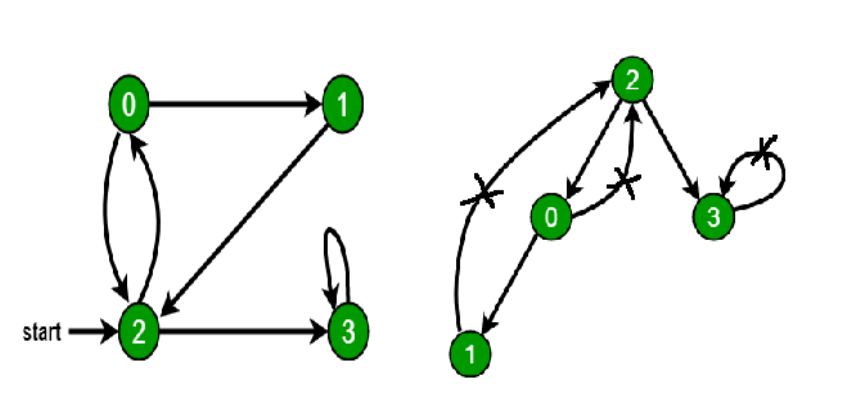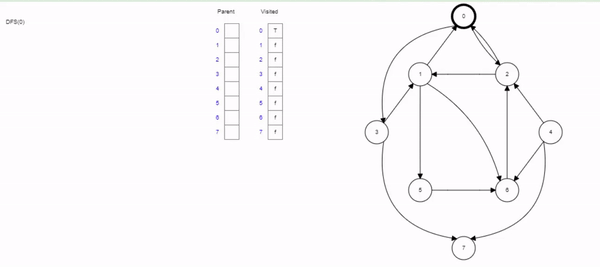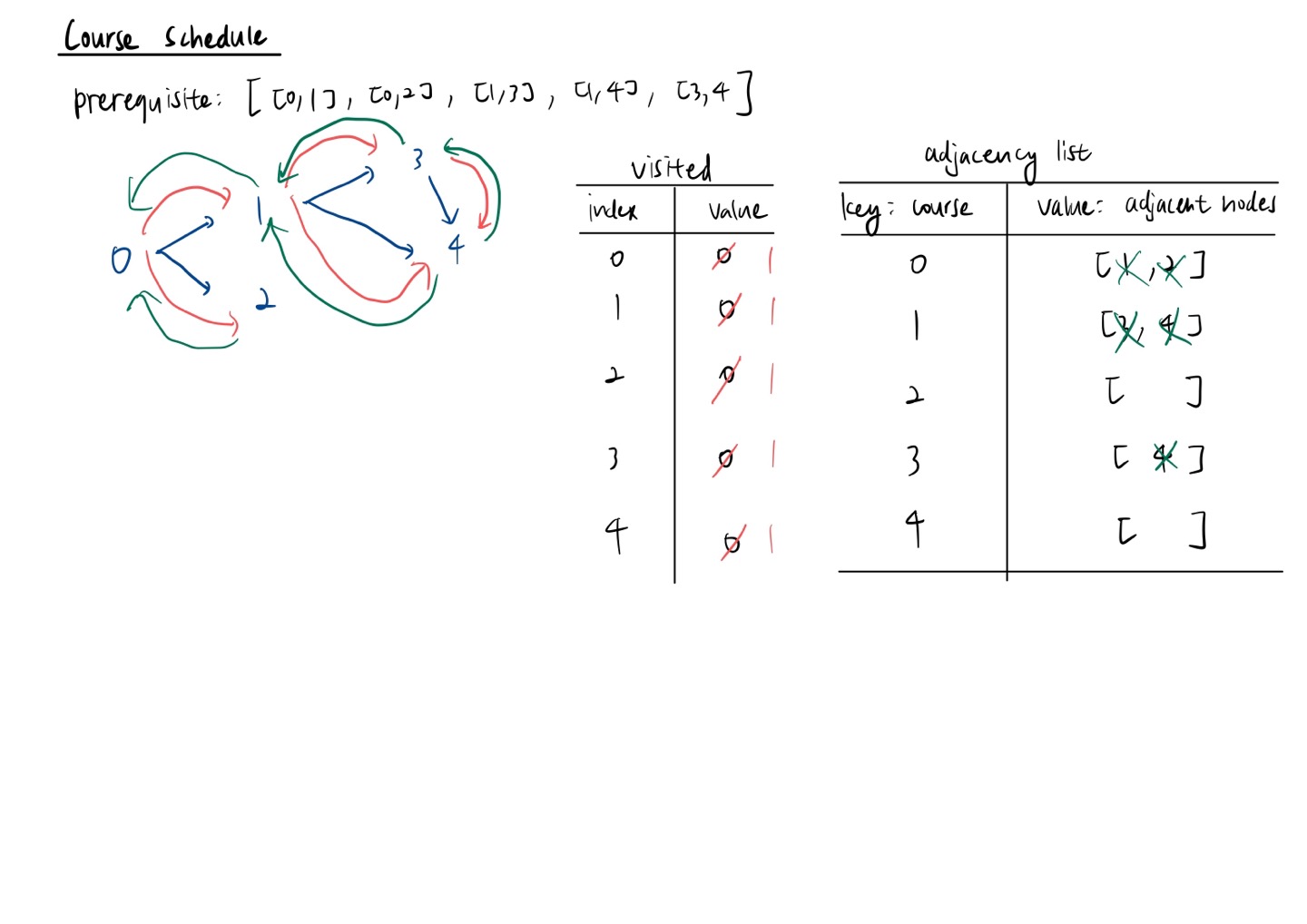(Leetcode) [Graph] Course schedule
Question
대학교 수강신청을 예시로 든 문제이다.
int numCourses: number of courses you have to take
vector
Approach
Consider this problem as a graph.
e.g. if course u is a prerequisite of course v, add a directed edge from node u to node v.
If a cycle is detected in the graph, then it is not possible to finish all courses.
How to detect cycle in a directed graph?
Use DFS (Depth First Search). DFS for a connected graph produces a tree.
If there is a back edge (self-loop or node to one if its ancestors) present in the graph, there is a cycle in a graph.

DFS (Depth First Search)
DFS is an algorithm for traversing or searching tree or graph data structures.
Basic idea: start from the root/any arbiytrary node, mark the node and move to the adjacent unmarked node and continue this loop until there is no unmarked adjacent node.
DFS는 말 그대로 깊이 우선 탐색이다.
그래프 상에 존재하는 임의의 한 정점으로부터 연결되어 있는 한 정점으로만 나아간다라는 방법을 우선으로 선택한다. 연결할 수 있는 정점이 있을 때까지 계속 연결하다가가 더이상 연결되지 않은 정점이 없으면 바로 그 전 단계의 정점으로 돌아가서 연결할 수 있는 정점이 있는지 살펴본다.
자료구조는 stack을 이용한다.
Time Complexity: O(V+E), where V=number of vertices, E=number of edges.
Algorithm of DFS
Use of recursive function.
Required features: index of the node and a visited array.
- Mark the current node as visited.
- Traverse all the adjacent and unmarked nodes and call recursive function with the index of the adjacent node.
class Graph {
public:
map<int, bool> visited;
map<int, vector<int>> adj;
void addEdge(int v, int w) {
adj[v].push_back(w); // add w to v's list (edge from v to w)
}
void DFS(int v) {
// return false if it meets a node which was visited (cycle is detected)
// if (visited[v]==true)
// return false;
// mark the current node as visited
visited[v] = true;
cout << v << " ";
// recur for all the vertices adjacent to this vertex
vector<int>::iterator i;
for (i=adj[v].begin(); i != adj[v].end(); i++) {
if (!visited[*i]) {
DFS(*i);
}
}
}
}

Solution
그래프에서 cycle이 발견되면 false, 아니면 true.
- Create a unordered map with key: course, value: list of adjacent nodes.
- Use vector
visitedto record all the visited nodes. - 중간에 false가 하나라도 나오면 dfs 함수 안에 있는 for loop에 인해서 연속으로 false가 나오기 때문에 returns false.
bool canFinish(int numCourses, vector<vector<int>>& prerequisites) {
unordered_map<int, vector<int>> adjacencyList(numCourses);
vector<int> visited(numCourses, 0);
// vector<int> visited;
// make list of prerequisites of all courses and add to a map.
for (int i=0; i<prerequisites.size(); i++) {
adjacencyList[prerequisites[i][0]].push_back(prerequisites[i][1]);
}
// since there may be more than one graph, loop is required.
for (int i=0; i<numCourses; i++) {
if (!dfs(i, adjacencyList, visited))
return false;
}
return true;
}
bool dfs(int course, unordered_map<int, vector<int>>& adjacencyList, vector<int> visited) {
// return false if the node is already visited
if (visited[course]==1)
return false;
// if (find(visited.begin(), visited.end(), course) != visited.end())
// return false;
if (adjacencyList[course].size()==0)
return true;
visited[course]=1; // mark node as visiting
// visited.push_back(course);
for (int i=0; i<adjacencyList[course].size(); i++) {
if (!dfs(adjacencyList[course][i], adjacencyList, visited))
return false;
}
// visited.pop_back();
adjacencyList[course] = {};
return true;
}

Runtime

유튜브에 neetcode라는 채널에 올라온 풀이를 봤을때 visited라는 list에 방문하고 있는 노드를 추가하고 넣고 하길래 vector push_back과 pop_back을 이용해서 추가하고 넣는 방식 하나와, 그냥 0으로 초기화된 numCourses 사이즈의 vector를 이용해서 방문하고 있는 노드를 1로 바꿔주는 방식 하나를 테스트 해보았다.
그 결과 넣고 빼는 방식이 runtime이 조금 더 기나 메모리를 확연히 덜 잡아먹는다.
코멘트
시간을 너무 오래 잡아먹었다. 삽질을 너무 많이 했다. 확실히 처음 배우는 DFS라는 개념이라 그렇기도 하고, 집중력도 흐트러졌다. 얼른 다음 문제로 넘어가야겠다.
References
https://www.geeksforgeeks.org/find-whether-it-is-possible-to-finish-all-tasks-or-not-from-given-dependencies/
https://www.youtube.com/watch?v=EgI5nU9etnU
Leave a comment